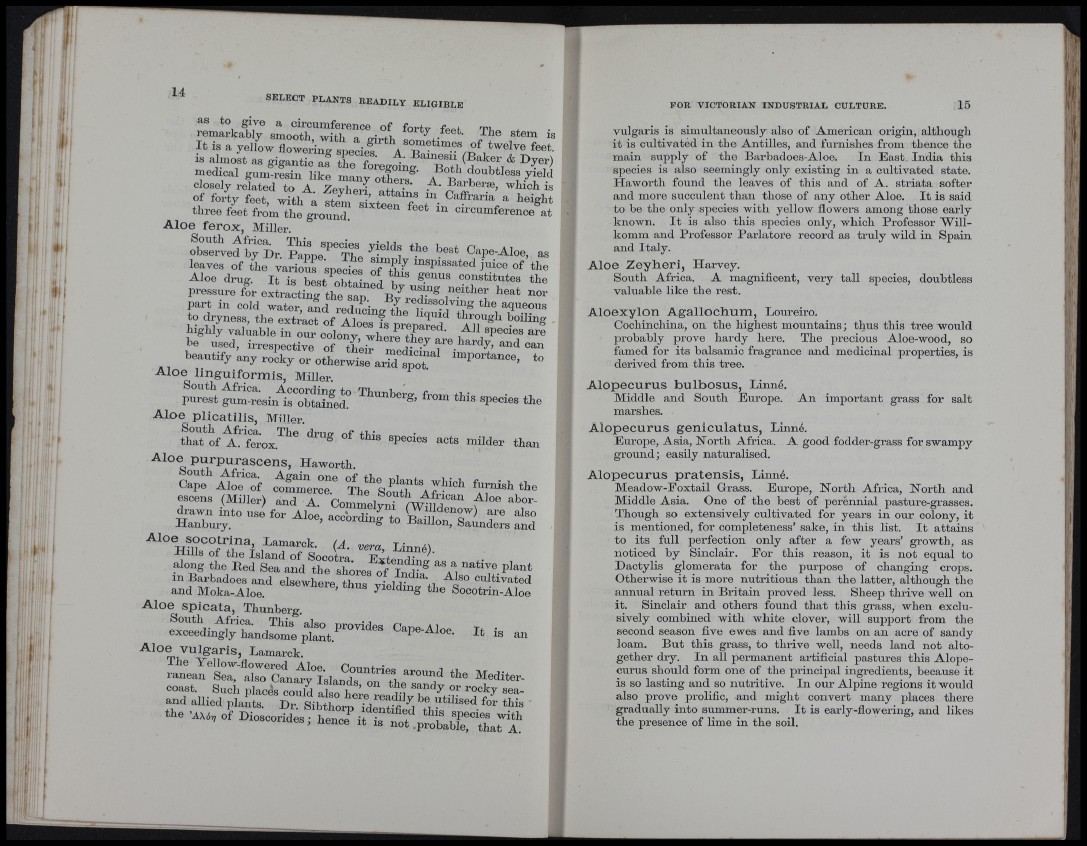
lllilL;
1!^:'
as to give a circumference of fortv fecf Tiv.. ^
remarkably smooth, with a airfL mrty ieet. The stem is
I t is a yellow flow e iC 1 3 A * "® '™ f®®‘-
is almost as gigaatio a? t K - e g o t f
medical gum-resin like manyothei , y ®*‘‘ doubtless yield
closely related to A Zevherf n+f • ' • which is
of forty feet, with a stem six te e znLi“ '- ^^ight
three feet from the ground. circumference at
Aloe ferox, Miller.
observed by ï)r. The ffimnl Cape-Aloe, as
leaves of the various species of th k B'i®® of the
Aloe drug. I t is best oTtaffip^ L constitutes the
pressure for extracting the sap p / neither heat nor
part in cold water, a Æ ^ f c i n . t i f^^^^^^^^
to dryness, the extract of Aloes is prepared aT ^ ^ •
nghly valuable in our colony where tW 1' are
be used, irrespective of their m p d t.7 and can
beautify any rocky or otherwise arid «0 0 ^
Aloe linguiformis, Miller.
purest gum-resin^irobtained° this species the
A lo e p lic a tilis , Miller.
South Africa. The druo’ nf
that of A. ferox. ® “ M w than
Aloe purpurascens, Haworth.
d m d r m t h V “ '’''
esoens (Miller) and A. C om m e lv r 7 3 3 “ Y°® “^ordrawn
into use for Aloe according tn 3 , , ®“ °"') m-e also
Hanbury. ’ o é Bâillon, Saunders and
H ^ T -Hills of tthfe Y Is l,an3d ”of® S'^-o cotr« l^v+ Linné).
along p e Eed Sea and the shires r f In d h f 3
in Barbadoes and elsewhere thuci vipm^ 3 cultivated
and Moka-Aloe. ’ Socotrin-Aloe
Aloe spicata, Thunberg.
I t ia an
Aloe vulgaris, Lamarck.
d d : 3 d l a n m m 3 ®®“ ‘- Snch places could also liele r e ^ L Z l r T r ^
and allied plants. Dr. Sibthorn idpniifi ^ this
the A . , of Hioscorides; h l 3 ^ f r n t ^ d d
vulgaris is simultaneously also of American origin, although
it is cultivated in the Antilles, and furnishes from tbence the
main supply of the Barbadoes-Aloe. In East India this
species is also seemingly only existing in a cultivated state.
Haworth found the leaves of this and of A. striata softer
and more succulent than those of any other Aloe. I t is said
to be the only species with yellow flowers among those early
known. I t is also this species only, which Professor Will-
komm and Professor Parlatore record as truly wild in Spain
and Italy.
Aloe Zeyheri, Harvey.
South Africa. A magniflcent, very tall species, doubtless
valuable like the rest.
Aloexylon Agallochum, Loureiro.
Cochinchina, on the highest mountains; thus this tree would
probably prove hardy here. The precious Aloe-wood, so
famed for its balsamic fragrance and medicinal properties, is
derived from this tree.
Alopecurus bulbosus, Linné.
Middle and South Europe. An important grass for salt
marshes.
Alopecurus geniculatus, Linné.
Europe, Asia, North Africa. A good fodder-grass for swampy
ground; easily naturalised.
Alopecurus pratensis, Linné.
Meadow-Eoxtail Grass. Europe, North Africa, North and
Middle Asia. One of the best of perennial pasture-grasses.
Though so extensively cultivated for years in our colony, it
is mentioned, for completeness’ sake, in this list. I t attains
to its full perfection only after a few years’ growth, as
noticed by Sinclair. For this reason, it is not equal to
Dactylis glomerata for the purpose of changing crops.
Otherwise it is moi-e nutritious than the latter, although the
annual return in Britain proved less. Sheep thiive well on
it. Sinclair and others found that this grass, when exclusively
combined with white clover, will support from the
second season five ewes and flve lambs on an acre of sandy
loam. But this grass, to thrive well, needs land not altogether
dry. In all permanent artiflcial pastures this Alopecurus
should form one of the principal ingredients, because it
is so lasting and so nutritive. In our Alpine regions it would
also prove proliflc, and might convert many places there
gradually into summer-runs. I t is early-flowering, and likes
the presence of lime in the soil.
iC li’